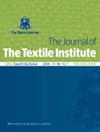Study on the sound absorption of jute fabrics: effects of woven factors and multilayer structures
IF 1.5
4区 工程技术
Q2 MATERIALS SCIENCE, TEXTILES
引用次数: 0
Abstract
AbstractAs porous materials, textiles have been widely used in noise reduction and control engineering due to the advantages of lightweight and easy processing. In this work, the effects of structural factors and physical properties of woven jute fabrics on sound absorption were investigated. Woven jute fabrics with different warp and weft density, thickness, areal weight, and bulk density are employed for acoustical impedance tube measurement, and the warp and weft flexural rigidity, and air permeability of woven jute fabric were measured. The relationship between structural characteristics and sound absorption properties was studied, which has provided good reference for the design of fabric texture. Furthermore, multilayered structure was also constructed by facile plying-up method, followed by the evaluation on the effects of various layering configuration, and then for improved sound absorption. This investigation has mainly focused on woven factors and physical properties, which is benefit to the fabrication of woven jute fabrics with optimal structural details for enhanced sound absorption.Keywords: Jute fabricwoven factorsmultilayer structuresound absorptionair permeability Disclosure statementNo potential conflict of interest was reported by the authors.Additional informationFundingThis research was supported by the Natural Science Foundation of China (No. 12004288), the Fundamental Research Funds for the Central Universities.黄麻织物吸声性能的研究:机织因素和多层结构的影响
摘要纺织品作为多孔材料,因其轻质、易加工等优点,在降噪和控制工程中得到了广泛的应用。研究了机织黄麻织物的结构因素和物理性能对其吸声性能的影响。采用不同经纬密度、厚度、面重和容重的机织黄麻织物进行声阻抗管测量,测量了机织黄麻织物的经纬抗弯刚度和透气性。研究了织物的结构特性与吸声性能之间的关系,为织物的纹理设计提供了良好的参考。在此基础上,采用简易叠层法构建了多层结构,评价了不同叠层结构的吸声效果。本文主要研究了黄麻织物的织构因素和物理性能,这有利于制作具有最佳结构细节的黄麻织物,以提高吸声性能。关键词:黄麻织物编织因素多层结构吸声透气性披露声明作者未报告潜在利益冲突。本研究得到国家自然科学基金(No. 12004288)、中央高校基本科研业务费专项资助。
本文章由计算机程序翻译,如有差异,请以英文原文为准。
求助全文
约1分钟内获得全文
求助全文
来源期刊

Journal of the Textile Institute
工程技术-材料科学:纺织
CiteScore
4.20
自引率
5.90%
发文量
149
审稿时长
1.0 months
期刊介绍:
The Journal of The Textile Institute welcomes papers concerning research and innovation, reflecting the professional interests of the Textile Institute in science, engineering, economics, management and design related to the textile industry and the use of fibres in consumer and engineering applications. Papers may encompass anything in the range of textile activities, from fibre production through textile processes and machines, to the design, marketing and use of products. Papers may also report fundamental theoretical or experimental investigations, including materials science topics in nanotechnology and smart materials, practical or commercial industrial studies and may relate to technical, economic, aesthetic, social or historical aspects of textiles and the textile industry.
All published research articles in The Journal of The Textile Institute have undergone rigorous peer review, based on initial editor screening and anonymized refereeing by two expert referees.
 求助内容:
求助内容: 应助结果提醒方式:
应助结果提醒方式:


